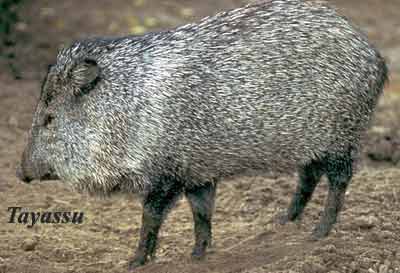 Tayassuidae
Tayassuidae| Cetartiodactyla | ||
| The Vertebrates | Suoidea |
| Vertebrates Home | Vertebrate | Vertebrate |
|
Abbreviated Dendrogram
Laurasiatheria
├─Ferae
└─┬─Perissodactyla
│
└─Cetartiodactyla
├─Cetacea
│ ├─Pakicetidae
│ └─Autoceta
└─Artiodactyla
├─Suina
│ ├─Hippopotamidae
│ └─Suoidea
│ ├─Sanitheriidae
│ └─┬─Tayassuidae
│ └─Suidae
│ ├─Hyotheriinae
│ └─┬─Tetraconodontinae
│ └─Suinae
└─Selenodontia
├─Camelidae
└─Ruminantia
├─Giraffoidea
└─┬─Bovoidea
└─Cervoidea
|
Contents
Overview |
Our knowledge of suoids is biased towards Africa and Europe. In Europe, the fossil record is well-explored and there are numerous Neogene exposures. Many parts of Africa are poorly known, and it offers relatively few and notably spotty Neogene sites. However, it is the presumed home of our own genus, and pigs are the biostratigraphic taxon of choice in hominid work. Hence, the African suoid record has been industriously explored and extensively published. These publications frequently bear the names of workers better known from physical anthropology than ungulate paleontology: most of the Leakys, Tim White, and Gen Suwa, to name but a few.
 Tayassuidae
TayassuidaeTha peccaries are another formerly cosmopolitan group of suines. According to Carroll [C88], they first appeared in North America in the Early Oligocene, and reached Europe by the Middle Oligocene. Since the land bridge from North America probably closed for the last time by the end of the Eocene, their origin may have been even earlier. In the Pliocene they radiated again into Asia and Africa, then reached South America when it contacted North America in the Pleistocene.
Note how closely the elaboration of the buccal ridge cusps and the buccal cingulum approach the selenodont condition by a completely diferent rouute.
 Suoidea: it would be more reasonable if this clade were defined as pigs + peccaries. However, this would be grossly inconsistent with historical usage.
Suoidea: it would be more reasonable if this clade were defined as pigs + peccaries. However, this would be grossly inconsistent with historical usage.
Range: from the Miocene at least), originating in Eurasia or Africa.
Phylogeny: Suina :::: Entelodontoidea + * : Sanitheriidae + (Tayassuidae + Suidae).
Characters: small incisors; canines arched laterally & showing a narrow terminal wear surface from digging; first premolar triangular; other premolars molariform.
Note: domestication is believed to have begun in Switzerland before 5000 BC
Image: from Artiodactyles des Faluns de Touraine
Links: Suoidea Mikko); artiodactyles French: follow link marked "Suidés" for pictures of Miocene teeth); Mammalia/UNGULATA/artiodactyla.html">Mammalia, Ungulata, Artiodactyla - Paarhufer German); Untitled (Czech); Graddy paper a fascinating blend of molecular and paleontological work). ATW030108.
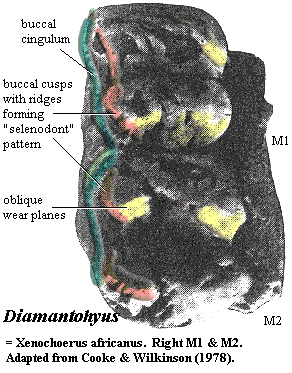 Sanitheriidae: Diamantohyus, Sanitherium. These two genera were previously regarded as both species of Xenochoerus the supposed ursuid.
Sanitheriidae: Diamantohyus, Sanitherium. These two genera were previously regarded as both species of Xenochoerus the supposed ursuid.
Range: Early Miocene to Middle Miocene of Europe, South Asia & Africa.
Phylogeny: Suoidea : (Tayassuidae + Suidae) + *.
Characters: molars buccal cingulum [CW78]; buccal cusps with both mesially and distally directed ridges wearing to approximate selenodont condition [CW78]; well separated, bunodont lingual cusps [CW78]; oblique wear planes [CW78]; accessory tubercles on linguodistal face of metaconid [CW78] .
References: Cooke & Wilkinson (1978) [CW78]. ATW040821.
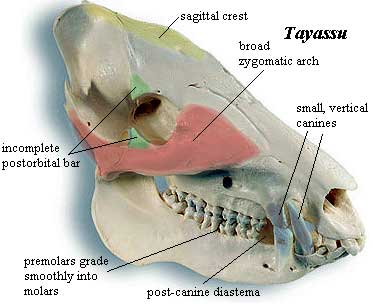 Tayassuidae: peccaries > pigs. Catagonus, Mylohyus, Perchoerus, Platygonus, Tayassu (= Dicotyles = Pecari).
Tayassuidae: peccaries > pigs. Catagonus, Mylohyus, Perchoerus, Platygonus, Tayassu (= Dicotyles = Pecari).
Range: from the Early Oligocene, with earliest forms known from North America [C88]. Cosmopolitan in past except Australia & Antarctica), but restricted to North & South America since Middle Miocene [CW78].
Phylogeny: Suoidea :: Suidae + *.
Characters: snout with mobile cartilagenous disk & terminal nostrils (as suids); sagittal crest present; zygomatic arch well developed; postorbital bar incomplete; ears ovate and erect; dental formula 2/3, 1/1, 3/3, 3/3; primitively, 3 upper incisors [C88] [1]; upper canines small (compared to suids); canines vertically oriented [CW78]; upper canine round in cross-section, with deep posterior open groove rounded-triangular, without indentation in suids); little or no sexual dimorphism in canine development; canines wear to form sharp cutting edge; diastema between canines & premolars; distal premolars molariform, smoothly grading into molars; molars quadrate & bunodont; molars simpler than in suids [C88]; tail short, with 6-9 vertebrae (another source says 6-7); limbs long & slim (compared to suids); limbs with only median digits (III & IV) functional (as pigs); only 1 additional, reduced digit [CW78]; metapodials III & IV fused proximally; hooves small (compared to suids); manus with 4 digits (contra [CW78]: 3 digits); pes with 2-3 digits; pelage bristly, with mane of long, stiff hairs on middorsal line from the crown to rump; stomach non-ruminating, but with 2-3 chambers [CW78]; dorsal rump scent gland used in social interactions [CW78]; gregarious; omniverous; diurnal foragers.
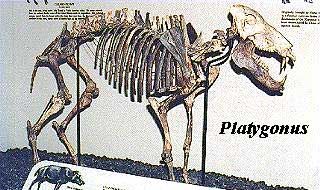 Notes: [1] this is surely an error, since, on the very next page [C88: 513], Carroll includes an illustration of the dentition of the Oligocene Perchoerus, which plainly has only two upper incisors.
Notes: [1] this is surely an error, since, on the very next page [C88: 513], Carroll includes an illustration of the dentition of the Oligocene Perchoerus, which plainly has only two upper incisors.
Links: Animal Diversity Web: Tayassuidae: Information; Tayassuidae Skulls from Skulls Unlimited; ARTIODACTYLA; TAYASSUIDAE- Peccaries; Peccary; The Collared Peccary - Javelina; Collared Peccary (Tayassu tajacu); InfoNatura Species Index- Family Tayassuidae; GeoZoo- Peccaries, or Javelinas! (family Tayassuidae); Tayassuidae; Kinds of Mammalia; Peccaries one of few sites to discuss paleontology. For our purposes, Best on the Web); Characterization of hair morphology in families of Tayassuidae and ...; Artiodactyl Identification good stuff on teeth of extinct genera); Mammalia/UNGULATA/TAYASSUIDAE/tayassuidae_01.html">Mammalia, Suidae German); APchap1.htm; Artiodactyla; What is a Suiforme (Artiodactyla)- inconclusive mtDNA study).
References: Carroll (1988) [C88], Cooke & Wilkinson (1978) [CW78]. ATW040821
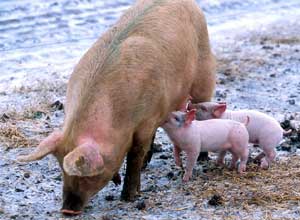 Suidae: pigs > peccaries
Suidae: pigs > peccaries
from the Oligocene of Europe and Asia, reaching Africa in the Miocene.
Phylogeny: Suoidea :: Tayassuidae + * : Hyotheriinae + (Tetraconodontinae + Suinae).
Characters: medium sized; skull long, large, with flat dorsal surface; snout with terminal cartilaginous disk pierced by nares; prenasal bone present, supporting snout; occipital crest strong, formed from supraoccipital parietals; orbits small & dorsal; eyesight usually poor; external ears small & pointed; hearing usually acute; dental formula 1-3/3, 1/1, 2-4/2 or 4, 3/3; distal upper incisors reduced; lower incisors almost horizontal, long, narrow; C1 ever-growing, projects out and posterior as curved tusks, with sharp edges formed by wear against c1; canines usually sexually dimorphic, better developed in males; molars bunodont or cuspidate; molars not high-crowned; M/m3 with numerous cusps; tail short; legs short; metapodials separate; digit I absent from manus & pes; unguals (hoof) present on all digits, but only III & IV function in locomotion; skin tough, thick with little hair; stomach with 2 chambers, but not ruminants; omnivorous and non-selective; typically nocturnal.
Links: Animal Diversity Web: Suidae: Information; Suidae Skulls from Skulls Unlimited; GeoZoo- Pigs and Relatives! (family Suidae); Suidae; suina page; Suiform Soundings; Fauna of Australia Volume 1b - Mammalia. ATW040806.
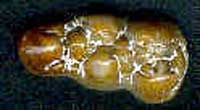 Hyotheriinae: Chleuastochoerus, Dubiotherium, Hyotherium, Sinapriculus.
Hyotheriinae: Chleuastochoerus, Dubiotherium, Hyotherium, Sinapriculus.
Range: Late Oligocene of Europe, by Early Miocene in Asia, Europe & Africa. Extinct in Early Pliocene?
Phylogeny: Suidae : (Tetraconodontinae + Suinae) + *.
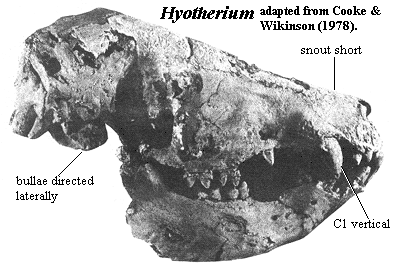 Characters: small [CW78]; snout not elongated [CW78]; tympanic bullae ovoid and directed horizontally [CW78]; canines vertical [CW78]; canines scrofic [CW78]; molars simple & bunodont [CW78].
Characters: small [CW78]; snout not elongated [CW78]; tympanic bullae ovoid and directed horizontally [CW78]; canines vertical [CW78]; canines scrofic [CW78]; molars simple & bunodont [CW78].
Links: Suidae- Hyotheriinae Mikko's Phylogeny); Graddy paper.
References: Cooke & Wilkinson (1978) [CW78]. ATW040821.
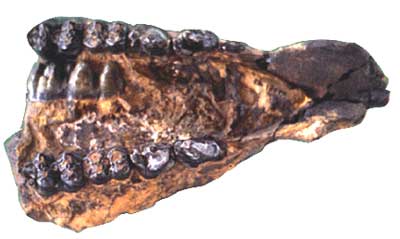 Tetraconodontinae: Conohyus, Lophochoerus, Notochoerus, Nyanzachoerus, Parachleuastochoerus, Sivachoerus, Tetraconodon
Tetraconodontinae: Conohyus, Lophochoerus, Notochoerus, Nyanzachoerus, Parachleuastochoerus, Sivachoerus, Tetraconodon
Range: Late Oligocene to Late Miocene of Europe & Asia, Late Miocene to Pliocene of Africa.
Phylogeny: Suidae :: Suinae + *.
Characters: posterior premolars greatly enlarged [CW78]; became specialized for durophagy [CW78].
Image: Jaw of Nyanzachoerus from Les carnets de l'archéologie.
Links: Suidae- Tetraconodontinae Mikko's Phylogeny); dents de mammifères image of Conohyus m3); France-diplomatie - Les carnets de l'archéologie image of Nyanzachoerus mandible).
References: Cooke & Wilkinson (1978) [CW78]. ATW040821.
checked ATW040705